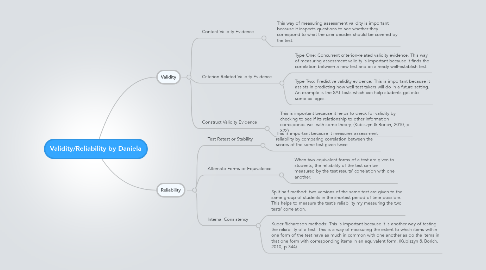
1. Validity
1.1. Content Validity Evidence
1.1.1. This way of measuring assessment validity is important because it inspects questions to see whether they correspond to what the user decides should be covered by the test.
1.2. Criterion Related Validity Evidence
1.2.1. Type One: Concurrent criterion-related validity evidence. This way of measuring assessment validity is important because it finds the correlation between a new test and an already well-establish test.
1.2.2. Type Two: Predictive validity evidence. This is important because it assists in predicting how well test takers will do in a future setting. An example is the SAT tests which can help students get into some colleges.
1.3. Construct Validity Evidence
1.3.1. This is important because it helps to check for validity by checking to see if its relationship to other information corresponds well with some theory, (Kubiszyn & Borich, 2010, p 322).
2. Reliability
2.1. Test Retest or Stability
2.1.1. This is important because it measures assessment reliability by comparing correlation between the scores of the same test given twice.
2.2. Alternate Forms or Equivalence
2.2.1. When two equivalent forms of a test are given to students, the reliability of the test can be measured by the test results' correlation with one another.
2.3. Internal Consistency
2.3.1. Split-half method: two versions of the same test are given to the same group of students in the shortest period of time possible. This helps to measure the test's reliability my measuring the two tests' correlation.
2.3.2. Kuder-Richardson methods: This is important because it is another way of testing the reliability of a test. This is a way of measuring the extent to which items within one form of the test have as much in common with one another as do the items in that one form with corresponding items in an equivalent form, (Kubiszyn & Borich, 2010, p 344).
